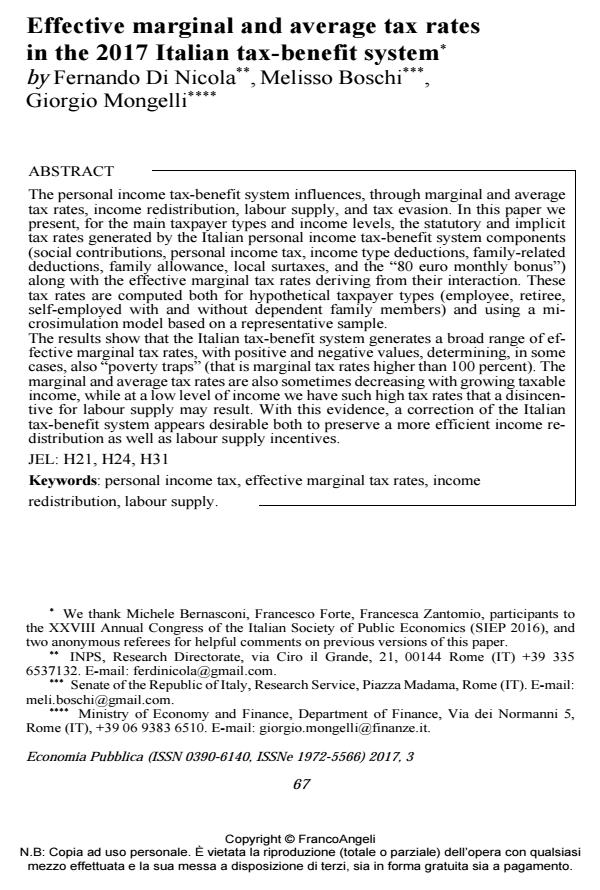Effective marginal and average tax rates in the 2017 Italian tax-benefit system
Journal title ECONOMIA PUBBLICA
Author/s Fernando Di Nicola, Melisso Boschi, Giorgio Mongelli
Publishing Year 2018 Issue 2017/3
Language English Pages 24 P. 67-90 File size 385 KB
DOI 10.3280/EP2017-003003
DOI is like a bar code for intellectual property: to have more infomation
click here
Below, you can see the article first page
If you want to buy this article in PDF format, you can do it, following the instructions to buy download credits

FrancoAngeli is member of Publishers International Linking Association, Inc (PILA), a not-for-profit association which run the CrossRef service enabling links to and from online scholarly content.
The personal income tax-benefit system influences, through marginal and average tax rates, income redistribution, labour supply, and tax evasion. In this paper we present, for the main taxpayer types and income levels, the statutory and implicit tax rates generated by the Italian personal income tax-benefit system components (social contributions, personal income tax, income type deductions, family-related deductions, family allowance, local surtaxes, and the "80 euro monthly bonus") along with the effective marginal tax rates deriving from their interaction. These tax rates are computed both for hypothetical taxpayer types (employee, retiree, self-employed with and without dependent family members) and using a microsimulation model based on a representative sample. The results show that the Italian tax-benefit system generates a broad range of effective marginal tax rates, with positive and negative values, determining, in some cases, also "poverty traps" (that is marginal tax rates higher than 100 percent). The marginal and average tax rates are also sometimes decreasing with growing taxable income, while at a low level of income we have such high tax rates that a disincentive for labour supply may result. With this evidence, a correction of the Italian tax-benefit system appears desirable both to preserve a more efficient income redistribution as well as labour supply incentives.
Keywords: Personal income tax, effective marginal tax rates, income redistribution, labour supply.
Jel codes: H21, H24, H31
- Aaberge R. and Colombino U. (2008). Designing Optimal Taxes With a Microeconometric Model of Household Labour Supply. CHILD Working Paper N.6.
- Aaberge R., Colombino U. and Wennemo T. (2002). Heterogeneity in the Elasticity of Labor Supply in Italy and Some Policy Implications. CHILD Working Paper N. 20.
- Baldini M., Giannini S. and Santoro A. (2017). Irpef, una riforma da fare. lavoce.info, April.
- Borri N., Nisticò S., Ragusa G. and Reichlin P. (2014). Cambiare l’Irpef pensando al lavoro. lavoce.info, February.
- Carone G., Immervoll H., Paturot D. and Salomäki A. (2004). Indicators of Unemployment and Low-Wage Traps. OECD Social, Employment and Migration, Working Paper N. 18, March.
- Congressional Budget Office (2012a). How the Supply of Labor Responds to Changes in Fiscal Policy. Report, October.
- Congressional Budget Office (2015). Effective Marginal Tax Rates for Low- and Moderate-Income Workers in 2016. Report, November.
- De Vincenti C. and Paladini R. (2009). Personal income tax design for Italy: Les-sons from the theory. Rivista Italiana degli Economisti, 1. DOI: 10.1427/30382
- Diamond P. (1998). Optimal income taxation: An example with a u-shaped pattern of optimal marginal tax rates. American Economic Review, 88(1): 83-95.
- Di Nicola F., Mongelli G. and Pellegrino S. (2015). The static microsimulation model of the Italian Department of Finance: Structure and first results regarding income and housing taxation. Economia Pubblica, 2: 125-157. DOI: 10.3280/EP2015-002004
- Di Nicola F. and Paladini R. (2017). A tax-benefit system reform for Italy. Paper presented at SIEP Conference, Catania, 22 September.
- Immervoll H. (2004). Average and Marginal Effective Tax Rates Facing Workers in the EU: A Micro-Level Analysis of Levels, Distributions and Driving Factors. OECD Social, Employment and Migration Working Papers, N. 19, December.
- Keane M. P. (2011). Labor Supply and Taxes: A Survey. Journal of Economic Literature, 49(4): 961-1075.
- Marino M. R. and Zizza R. (2012). Personal Income Tax Evasion in Italy: An Estimate by Taxpayer Type. In: Tax Evasion and the Shadow Economy. Edward Elgar, Chapter 3.
- McAlister F., Bandyopadhyay D., Barro R., Couchman J., Gemmell N. and Liao G. (2012). Average Marginal Income Tax Rates for New Zealand, 1907-2009. New Zealand Treasury Working Paper 12/04, September.
- McClelland R. and Mok S. (2012). A Review of Recent Research on Labor Supply Elasticities. Congressional Budget Office Working Paper N. 12.
- Meghir C. and Phillips D. (2010). Labour Supply and Taxes. In: Besley T., Blundell R., Gammie M., and Poterba J. (editors). Dimensions of Tax Design: the Mirrlees Review. Oxford University Press, pp. 202-274.
- Milanovic B. (2016). Global inequality: a new approach for the age of globalization. Cambridge, Massachussets, USA: Belknap Harvard University Press, pp.212-239.
- Ministry of Economy and Finance (2014). Rapporto sulla realizzazione delle strategie di contrasto all’evasione fiscale, sui risultati conseguiti nel 2013 e nell’anno in corso, nonché su quelli attesi, con riferimento sia al recupero di gettito derivante da accertamento all’evasione che a quello attribuibile alla maggiore propensione all’adempimento da parte dei contribuenti, August.
- Piketty T., Saez E. and Stantcheva S. (2013). Optimal taxation of top labor in-comes: A tale of three elasticities. American Economic Journal: Economic Pol-icy, 6(1): 230-71.
- Saez E. (2001). Using Elasticities to Derive Optimal Income Tax Rates. Review of Economics Studies, 68(1): 205-229.
- Yearning for Inclusive Growth and Development, Good Jobs and Sustainability Paolo Di Caro, pp.175 (ISBN:978-3-030-23052-4)
- Thin Capitalisation Rules: A Second-Best Solution to the Cross-Border Debt Bias? Ann Kayis-Kumar, in SSRN Electronic Journal /2015
DOI: 10.2139/ssrn.2636645
Fernando Di Nicola, Melisso Boschi, Giorgio Mongelli, Effective marginal and average tax rates in the 2017 Italian tax-benefit system in "ECONOMIA PUBBLICA " 3/2017, pp 67-90, DOI: 10.3280/EP2017-003003